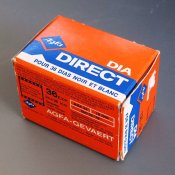Super cool -- thanks for trying this out Athril!
Gerald's formulation uses 50g CuSo4 at full strength, while the quoted Tim Rudman formula calls for 5g CuSo4 in the working strength solution. Could this tenfold disparity between formulae be the reason some have experienced softening while others have not?
Alessandro asked what the advantages a copper sulphate bleach might have over permanganate. One additional advantage I can see is that the copper sulphate bleach is stable in solution, whereas permanganate is not. This might not matter much for film, but if you want to do a longer printing session using a reversal process, this could make a difference. (In a related thought, I guess that this process would not work with azo/chloride containing emulsions, since the weak silver solvent couldn't distinguish between AgCl in the positive unexposed image and the AgCl in the bleached image.)
Also, I'm wondering, since we're making a rehal bleach, why not use ferricyanide with chloride? It might not cause the emulsion softening of permanganate bleaches (or even copper), plus it is readily available due to its use for other photographic processes. [Edit: Just saw Athril already suggested this] Normally, a rehal bleach using chloride has the problem that chloride ions cause a blixing effect, reducing density. However, in the application of reversal processing film, you normally add a silver solvent somewhere in the process anyways, to clear the highlights, so perhaps a mild blixing would be fine if the solvent effect elsewhere in the process was reduced to compensate.
Likewise, as Athril suggested, a rehal bleach using iodide normally has the deficiency of incomplete redevelopment in the shadows, but this could potentially be used to differentiate between the bleached negative and unexposed positive by developing incompletely.
This all really fascinates me, someday soon I think I'm going to try a ferricyanide bleach with NaCl and removing the bleached image with dilute ammonia (after thorough rinse of course).
Thanks also for the safety warning on ammoniacal silver solutions. The amount of ammonium is far in excess of the amount of silver (but still remains at a low concentration -- 2%), so I think Ag2O will predominate over Ag3N. Even so, I did a rough calculation of the worst case scenario and found that even if I processed 4 rolls of 120, and all of the silver of a very silver-rich (x-ray) emulsion were converted to Ag3N, 0.01 mol of Ag3N would be produced. Using the standard energy of formation of 315 kJ/mol, about 3.2 kJ (or 0.75 Calories, equivalent to the energy in about 1/10 of a potato chip) could be liberated, so I'm thinking this wouldn't be too much of a risk. Is that right?
Gerald's formulation uses 50g CuSo4 at full strength, while the quoted Tim Rudman formula calls for 5g CuSo4 in the working strength solution. Could this tenfold disparity between formulae be the reason some have experienced softening while others have not?
Alessandro asked what the advantages a copper sulphate bleach might have over permanganate. One additional advantage I can see is that the copper sulphate bleach is stable in solution, whereas permanganate is not. This might not matter much for film, but if you want to do a longer printing session using a reversal process, this could make a difference. (In a related thought, I guess that this process would not work with azo/chloride containing emulsions, since the weak silver solvent couldn't distinguish between AgCl in the positive unexposed image and the AgCl in the bleached image.)
Also, I'm wondering, since we're making a rehal bleach, why not use ferricyanide with chloride? It might not cause the emulsion softening of permanganate bleaches (or even copper), plus it is readily available due to its use for other photographic processes. [Edit: Just saw Athril already suggested this] Normally, a rehal bleach using chloride has the problem that chloride ions cause a blixing effect, reducing density. However, in the application of reversal processing film, you normally add a silver solvent somewhere in the process anyways, to clear the highlights, so perhaps a mild blixing would be fine if the solvent effect elsewhere in the process was reduced to compensate.
Likewise, as Athril suggested, a rehal bleach using iodide normally has the deficiency of incomplete redevelopment in the shadows, but this could potentially be used to differentiate between the bleached negative and unexposed positive by developing incompletely.
This all really fascinates me, someday soon I think I'm going to try a ferricyanide bleach with NaCl and removing the bleached image with dilute ammonia (after thorough rinse of course).
Thanks also for the safety warning on ammoniacal silver solutions. The amount of ammonium is far in excess of the amount of silver (but still remains at a low concentration -- 2%), so I think Ag2O will predominate over Ag3N. Even so, I did a rough calculation of the worst case scenario and found that even if I processed 4 rolls of 120, and all of the silver of a very silver-rich (x-ray) emulsion were converted to Ag3N, 0.01 mol of Ag3N would be produced. Using the standard energy of formation of 315 kJ/mol, about 3.2 kJ (or 0.75 Calories, equivalent to the energy in about 1/10 of a potato chip) could be liberated, so I'm thinking this wouldn't be too much of a risk. Is that right?


 off point......
off point......


